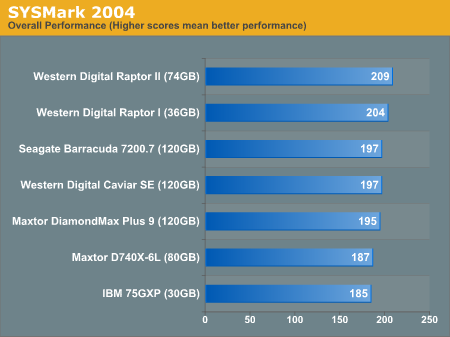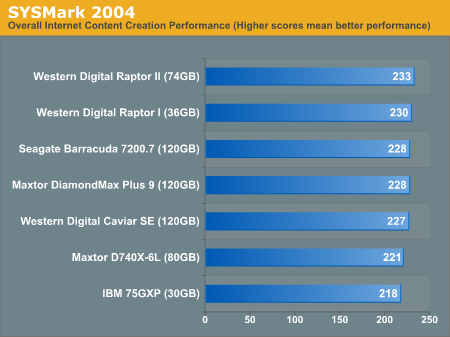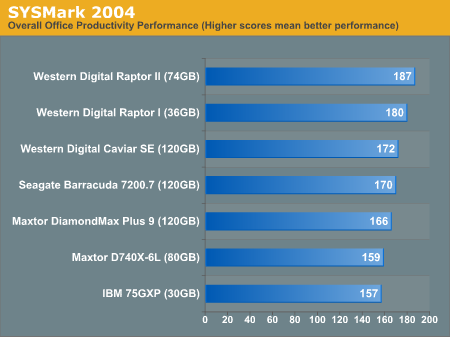Q2 2004 Desktop Hard Drive Comparison: WD Raptor vs the World
by Anand Lal Shimpi on June 7, 2004 12:05 AM EST- Posted in
- Storage
SYSMark Performance Summary
The overall SYSMark scores summarize what we've seen thus far:

As a recap, here's what happens with the Internet Content Creation suite:
"In this scenario, the content creator creates a product-related website targeting a broadband and narrowband audience. The user first renders a 3D model to a bitmap, while preparing web pages using a web site publishing tool. The user opens a video editing package, creates a movie from several raw input movie cuts and sound cuts and starts exporting it. While waiting on this operation, the user imports the rendered image into an image-processing package, modifies it and saves the results. Back in the 3D modeling software, the user modifies a 3D model and exports it to a vector-graphics format. Once the movie is assembled, the user edits it and creates special effects using one of the modified images as input. The user extracts content from an archive. Meanwhile, he uses an animation creation tool to open the exported 3D vector graphics file. He modifies it by including other pictures and optimizes it for faster animation. The final movie with the special effects is then compressed in a format that can be broadcast over broadband Internet. The web site is given the final touches and the system is scanned for viruses."

In the Internet Content Creation tests, we see that although there is a difference in performance between current and previous generation hard drives, there's very little that separates the 10,000RPM Raptors from the 7200RPM drives.
Also recapping, here's what happens in the entire Office Productivity suite:
"In this scenario, the office productivity user creates a marketing presentation and supporting documents for a new product. The user receives email containing a collection of documents in a compressed file. The user reviews his email and updates his calendar while a virus checking software scans the system. The corporate web site is viewed and the user begins creating the collateral documents. The user also accesses a database and runs some queries. A collection of documents are compressed. The queries' results are imported into a spreadsheet and used to generate graphical charts. The user then transcribes a document. Once the document has all the necessary pieces in place, the user changes it into a portable format for easy and secure distribution. The user edits and adds elements to a slide show template. Finally, the user looks at the results of his work (both the slide show and the portable document) in an Internet browser. "

Office Productivity paints a much different picture, with significant advantages being seen over older drives. The Office Productivity suite also paints a much more compelling picture of the Raptors' performance; even the older Raptor manages to maintain a decent performance advantage over the cream of the crop 7200RPM 8MB Parallel ATA drives.
Overall performance is an average of the two suites, and thus, we see that a lot of the impressive performance gains in Office Productivity are diluted by the relatively little variation in Internet Content Creation performance.










50 Comments
View All Comments
MikhailT - Wednesday, June 9, 2004 - link
For a gamer, it would be a better idea to get a single 74gb raptor instead of raid0 with 2x36 raptors. I don't think there will be any difference between both situation. Raid0 might have data failure issue over long term no?ElFenix - Wednesday, June 9, 2004 - link
I'd like to see the SATA version of the 7200.7 myself, SR generally feels that the SATA version is somewhat faster than the PATA version.Also, about the Hitachis... they tend to 'meow' at you every once in a while... supposedly that increases their reliability, but when i'm going for silence it isn't wanted. When silence is key i'll go with the ultra-quiet, reliable, non-meowing, still fast, and dirt cheap ($0.35/gig) 7200.7
T8000 - Tuesday, June 8, 2004 - link
#36, it is nice to know you did get a performance boost, but I would like to ask what drive you had before and if you bought the 74 GB Raptor.This is important, because there is a large performance difference between the latest 7200 RPM drives and the early sub 20 GB ones.
Also, SCSI drives are famous for their loud whining noise, so a lot of people I heard would not even use a SCSI drive if it would be free, unless they become more silent, so this may be a good reason why SCSI drives are not used much in workstations.
Tostada - Tuesday, June 8, 2004 - link
The SATA Hitachi Deskstar 7K250 (which has 8MB cache and a 3-year warranty) is generally cheaper, faster, and quieter than every comparable drive. Well, the Samsung is a little quieter. The Hitachi 7K250 is about as fast as a Raptor 36G, though. In my experience, the only practical drives to buy these days are:Samsung for ATA
Hitachi 7K250 for SATA
Raptor 740GD for SATA if you want the absolute best performance.
Look at NewEgg's current price of the Hitachi 7K250 SATA line with 8MB cache and 3-year warranty:
80GB = $74.00 delivered
160GB = $103.50 delivered
250GB = $194.00 delivered
Raptor 740GD = $200.00 delivered
The Raptor 740GD is 25% faster in some situations. Still, in most systems I would prefer to spend $200 for a RAID of two 160GB Hitachi's instead of a single 74GB Raptor.
I see many people still recommending WD's non-Raptor drives, which just don't keep up. Here's some stats from StorageReview.
High-End DriveMark 2002:
Raptor 740GD: 585 IO/sec
Raptor 360GD: 467 IO/sec
Hitachi 7K250: 442 IO/sec
WD800JB: 375 IO/sec
StorageReview Gaming DriveMark 2002:
Raptor 740GD: 749 IO/sec
Raptor 360GD: 588 IO/sec
Hitachi 7K250: 588 IO/sec
WD800JB: 477 IO/sec
WB99 Max Read Transfer Rate:
Raptor 740GD: 71.8 MB/sec
Raptor 360GD: 57.4 MB/sec
Hitachi 7K250: 60.4 MB/sec
WD800JB: 49.3 MB/sec
Idle Noise:
Raptor 740GD: 42.3 dB/A
Raptor 360GD: 43.1 dB/A
Hitachi 7K250: 41.5 dB/A
WD800JB: 45.0 dB/A
tmhartsr - Tuesday, June 8, 2004 - link
Recently upgraded my primary desktop to Raptor 10K. Actual improvement in everyday system performance and quickness is very noticable! An excellent practical measure of disk performance is writing/restoring a Ghost Image between two of these various drives. The difference is strikingly clear in this real world measure. I think disk performance has been much overlooked recently and deserves much more attention. Also that SCSI 320 should always be included in these comparisions. SCSI 320 is under-utilized in high end systems? Also what effect will new PCI Express boards have on HD performance and development?Kravahn - Tuesday, June 8, 2004 - link
A little clarification... I'm used to seeing frank recommendations on AnandTech, and this was more than ambiguous. It should have said... 'if you want the best performance possible, the latest Raptor is for you; with that in mind, nearly equivalent performance, and certainly more bang for the buck can be had with the current 8MB PATA iterations tested here.'Kravahn - Tuesday, June 8, 2004 - link
Another point regarding final analyses... a 10% increase in performance is definitely notable, but when that 10%increase relates to a 39 second vs. a 42 second load time, it becomes negligible. It seems silly to me to pay more money for less storage to save three seconds. The geek in me loves the numbers, but as a reseller it's hard for me to sell a product just because it's a little faster, especially when my customer would be sacrificing 50G of storage. I think the summary should include a bit of reality and not just factual conclusions.Mackintire - Monday, June 7, 2004 - link
demonbug - Monday, June 7, 2004 - link
First of all, great HD performance comparison - I just have a nitpick. My only comment is in regards to the game loading test. You must have one quick thumb on the stopwatch to measure down to the ten-thousandth of a second as you show on the graphs. I know, probably comes from averaging, but come on - round it to the nearest tenth, or hundredth at least (if you think you were really that quick with the stopwatch). Didn't they ever teach you about significant digits in school?GOSHARKS - Monday, June 7, 2004 - link
discussion regarding the article in the forums:http://forums.anandtech.com/messageview.cfm?catid=...
i have to say that the article really suprised me and the results are quite INTERESTING